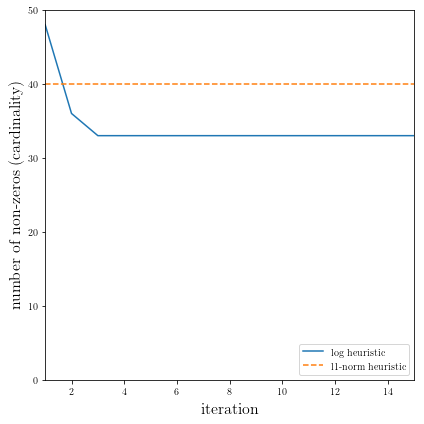计算线性不等式集合的稀疏解
由Judson Wilson于2014年5月11日进行的衍生作品。改编自Almir Mutapcic于2006年2月28日的同名CVX示例。
主题参考:
Boyd&Vandenberghe的第6.2节“凸优化”
Tropp的“Just relax: Convex programming methods for subset selection and sparse approximation”
介绍
我们考虑一组可行的线性不等式 \(Ax \preceq b\)。我们采用两种启发式方法来寻找满足这些不等式的稀疏点 \(x\)。
寻找稀疏解的(标准) \(\ell_1\)-范数启发式方法为:
基于对数的启发式方法是一种迭代方法,用于寻找稀疏解,通过找到问题的局部最优点:.. math:
\begin{array}{ll}
\mbox{最小化} & \sum_i \log \left( \delta + \left|x_i\right| \right) \\
\mbox{满足约束} & Ax \preceq b,
\end{array}
其中 \(\delta\) 是一个小阈值(用于确定一个值是否接近于零)。我们无法解决这个问题,因为它是一个凹函数的最小化问题,因此不是一个凸问题。然而,我们可以应用一种启发式方法来线性化目标函数,求解并迭代。这变成了一个加权的 \(\ell_1\)-范数启发式算法:
其中在每次迭代中,根据以下规则重新调整权重 \(W_i\):
其中 \(\delta\) 是一个小阈值。
该算法在以下论文中有描述:
“An affine scaling methodology for best basis selection” by B. D. Rao and K. Kreutz-Delgado
“Portfolio optimization with linear and fixed transaction costs” by M. S. Lobo, M. Fazel, and S. Boyd生成问题数据
import cvxpy as cp
import numpy as np
# 修正随机数生成器以便我们可以重复实验。
np.random.seed(1)
# 我们认为低于这个阈值的元素为零。
delta = 1e-8
# 问题维度(m个不等式在n维空间中)。
m = 100
n = 50
# 构造一组可行的不等式。
# (这个系统对于x0点是可行的。)
A = np.random.randn(m, n)
x0 = np.random.randn(n)
b = A.dot(x0) + np.random.random(m)
\(\ell_1\)-范数启发式算法
# 创建变量。
x_l1 = cp.Variable(shape=n)
# 创建约束条件。
constraints = [A*x_l1 <= b]
# 构造目标函数。
obj = cp.Minimize(cp.norm(x_l1, 1))
# 构造并解决问题。
prob = cp.Problem(obj, constraints)
prob.solve()
print("状态: {}".format(prob.status))
# 解的非零元素个数(其基数或多样性)。
nnz_l1 = (np.absolute(x_l1.value) > delta).sum()
print('在R^{}中找到一个可行的x,它有{}个非零元素。'.format(n, nnz_l1))
print("最优目标函数值: {}".format(obj.value))
状态: 最优
在R^50中找到一个可行的x,它有40个非零元素。
最优目标函数值: 28.582394099513873
迭代日志启发式算法
# 进行15次迭代,为每次运行分配变量以保存非零个数(x的基数)。
NUM_RUNS = 15
nnzs_log = np.array(())
# 将W存储为正参数,以便简单修改问题。
W = cp.Parameter(shape=n, nonneg=True);
x_log = cp.Variable(shape=n)
# 初始权重。
W.value = np.ones(n);
# 设置问题。
obj = cp.Minimize( W.T*cp.abs(x_log) ) # 逐元素积的和
constraints = [A*x_log <= b]
prob = cp.Problem(obj, constraints)
# 进行问题的迭代,并解决和更新W。
for k in range(1, NUM_RUNS+1):
# 解决问题。
# ECOS求解器在此问题上存在已知的数值问题,所以要强制使用其他求解器。
prob.solve(solver=cp.CVXOPT)
# 检查错误。
if prob.status != cp.OPTIMAL:
raise Exception("求解器未收敛!")
# 显示解向量中新的非零个数。
nnz = (np.absolute(x_log.value) > delta).sum()
nnzs_log = np.append(nnzs_log, nnz);
print('迭代{}:在R^{}中找到了一个可行的x,其中非零个数为{}...'.format(k, n, nnz))
# 逐元素调整权重并重新迭代
W.value = np.ones(n)/(delta*np.ones(n) + np.absolute(x_log.value))
Iteration 1: Found a feasible x in R^50 with 48 nonzeros...
Iteration 2: Found a feasible x in R^50 with 36 nonzeros...
Iteration 3: Found a feasible x in R^50 with 33 nonzeros...
Iteration 4: Found a feasible x in R^50 with 33 nonzeros...
Iteration 5: Found a feasible x in R^50 with 33 nonzeros...
Iteration 6: Found a feasible x in R^50 with 33 nonzeros...
Iteration 7: Found a feasible x in R^50 with 33 nonzeros...
Iteration 8: Found a feasible x in R^50 with 33 nonzeros...
Iteration 9: Found a feasible x in R^50 with 33 nonzeros...
Iteration 10: Found a feasible x in R^50 with 33 nonzeros...
Iteration 11: Found a feasible x in R^50 with 33 nonzeros...
Iteration 12: Found a feasible x in R^50 with 33 nonzeros...
Iteration 13: Found a feasible x in R^50 with 33 nonzeros...
Iteration 14: Found a feasible x in R^50 with 33 nonzeros...
Iteration 15: Found a feasible x in R^50 with 33 nonzeros...
结果绘图
以下代码绘制了:math:ell_1-范数启发式算法的结果,以及每次迭代的log启发式算法的结果。
import matplotlib.pyplot as plt
# 在ipython中内联显示图形。
%matplotlib inline
# 图形属性。
plt.rc('text', usetex=True)
plt.rc('font', family='serif')
plt.figure(figsize=(6,6))
# 绘制两个数据系列。
plt.plot(range(1,1+NUM_RUNS), nnzs_log, label='log启发式算法')
plt.plot((1, NUM_RUNS), (nnz_l1, nnz_l1), linestyle='--', label='l1范数启发式算法')
# 格式化并显示图形。
plt.xlabel('迭代次数', fontsize=16)
plt.ylabel('非零个数(基数)', fontsize=16)
plt.ylim(0,n)
plt.xlim(1,NUM_RUNS)
plt.legend(loc='lower right')
plt.tight_layout()
plt.show()
